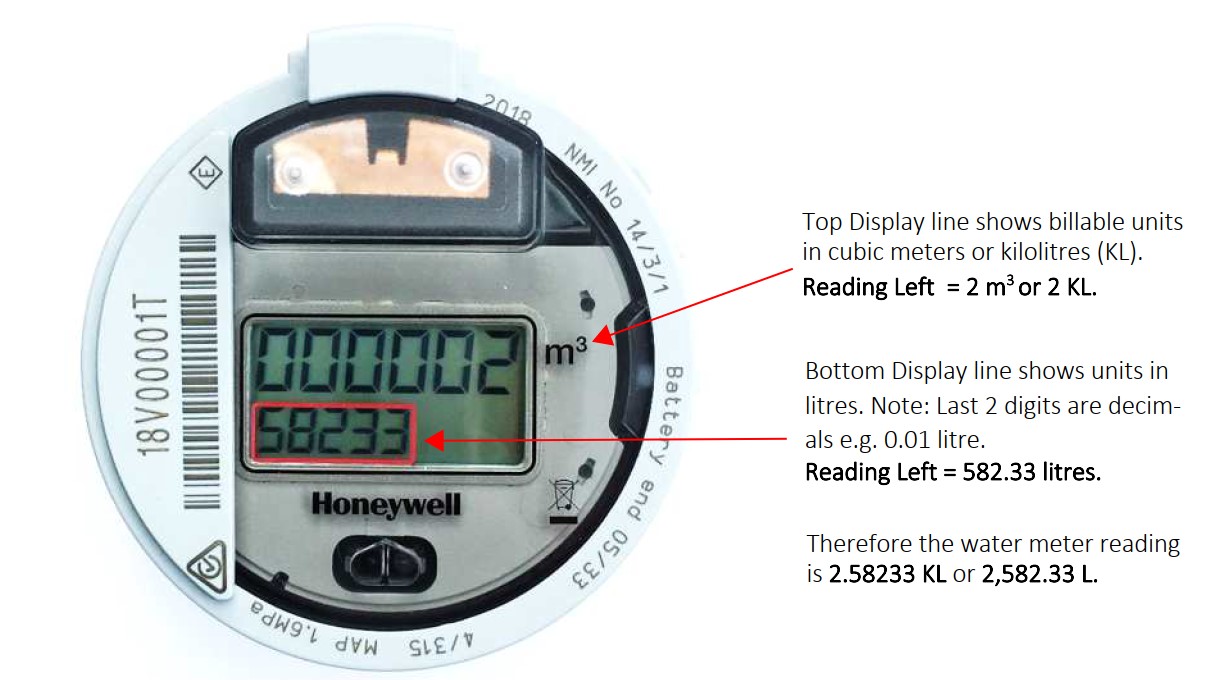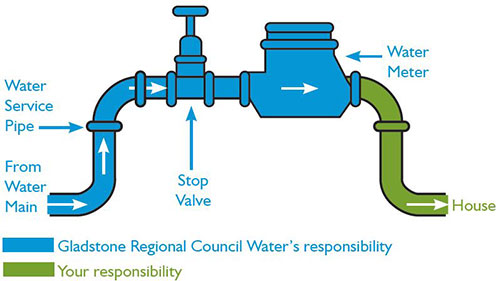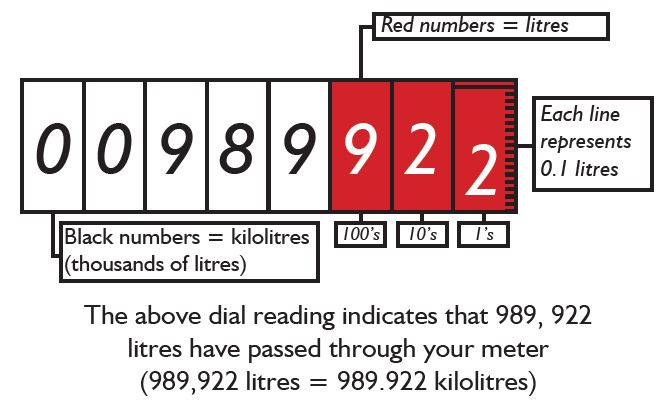Living Here
- Pets and Animals
- Residents
- Report
- Environment
- BackEnvironment
- Air Quality
- Biodiversity
- Biosecurity
- Blue-green algae blooms
- Bushfire Mitigation
- Coasts and Coastal Vegetation
- CoastSnap
- Conservation Programs and Initiatives
- Erosion and Sediment Control
- Feral Animals
- First Nations Fire and Land Officer
- Landfill Gas Abatement
- Mosquitoes
- Pests and Weeds
- Weed Spray Equipment Hire
- Wildlife
- Community Development
- Community Investment
- Services
- Emergencies
How to read your water meter
Calculating your next bill
Water meter protection
Increased water use
Make water wise changes
How to read your water meter
The following images show you how to read your water meter and keep track of how much water your household is using.
Most meters are metric and read in kilolitres.
Mechanical water meter and/or mechanical water meter with advanced water meter sensor added
Advanced water meter

Calculating your next bill
You can use your water meter reading to calculate your next water consumption bill.
Step 1: Take down your current meter reading then subtract the reading from your most recent notice
Step 2: Multiply this amount by the current water consumption charge for your water scheme
If you need help reading your water meter, or it looks different to the images above, please contact Council for assistance.
Find out how to estimate your daily water usage using our Water Usage Calculator.
Water meter protection

Maintenance
Any maintenance to water meters is the responsibility of Council and it is illegal for residents to tamper with the water meter. Should residents notice the water meter is leaking or has sustained damage please contact Council. Residents should be aware that any intentional damage to the water meter will be an expense to the owner.
Tampering is illegal
As the water service provider for the region, under the Water Supply (Safety and Reliability) Act 2008, Gladstone Regional Council is the asset owner of the reticulated water network infrastructure up to and including the water meter.
Reducing recorded consumption is an illegal practice and can result in any or all of the below consequences:
- Criminal Charges
- Wilful damage
- Theft of property
- Fraud
- Offences (Water Act)
- Unauthorised taking, supply of interfering with water
- Tampering with devices (including service)
- Connecting to mains or services without approval
- Interfering with Council’s assets
- Take water without approval.
Residents who notice damage to their water meter, or who have any queries or concerns regarding their water supply, should contact Council on (07) 4970 0700.
Increased water use
Has your water usage increased?
Steps to take if your water usage is unusually high
Consider plausible reasons
Your water use can increase if you have installed new appliances or fittings such as a dishwasher, evaporative air-conditioner or shower head. Other plausible reasons are filling a swimming pool, frequently watering a lawn or an increase in the number of people staying in your home.
Check your water meter reading
Your water meter may have been misread if the current reading is less than the reading on your account. In this instance, please contact Council.
Your water meter is usually located at the front of your property near a side boundary. The meter is divided into kilolitres (thousands of litres) and litres. Council records the kilolitre reading only.
Check for leaking taps and devices
A lot of water can be lost because of leaking pipes and dripping taps. Just one slow dripping tap can waste 9,000 litres of water per year, while a visibly leaking toilet can waste more than 60,000 litres.
- Check for dripping taps and leaking washing machine and dishwasher connections and hot water systems. Also look for damp patches on walls, bricks and garden areas.
- Check for faulty top-up systems, such as pools and water tanks.
Check your irrigation system
Irrigation can use up to 130 litres of water per minute so incorrect timings or leaks can quickly increase your water use.
- Check for broken sprinkler heads and leaks, where your irrigation pipes are visible.
- Check that your watering program is still correct – it can malfunction, for example, after a power outage.
- Check for underground leaks:
- Set each station for two minutes
- Take a reading of your water meter before running the first station
- Write down the reading again once the two minutes has run through and calculate how much water was used
- Repeat this for all stations
- If one or more stations recorded a significantly higher amount of water passing through than others, you probably have a leak somewhere.
Check for other concealed leaks
Do an overnight check of your water meter to identify any unaccounted for water usage.
- Turn off all water appliances, such as showers, washing machine, irrigation, fridge (if connected to water mains), icemaker and dishwasher before going to bed.
- Read and record both the black and red numbers from your meter.
- Each time a toilet is flushed during the night, factor in approximately nine litres of water usage.
- Read and record the reading first thing in the morning.
If any of the numbers have moved, you may have a water leak. If you are satisfied that you correctly factored in toilet flushes and turned off all water using appliances call a licensed plumber. All leaks on the property side of the meter are the responsibility of the owner.
Make water wise changes
In addition to the previous steps to solve water use fluctuations, you can make everyday changes to ensure your water use is reduced overall.
Laundry: Select a washing machine with a four-star rating or better. Front loading washing machines can use up to 50% less water, 35% less detergent and 30% less energy than top loaders.
Bathroom: We use more water in our bathrooms than in any other part of the house so take shorter showers; install a four-star dual flush toilet to save up to eight litres with every flush; and turn the tap off while brushing your teeth or shaving to save 15 litres per minute.
Garden: Don’t overwater; mulch generously as it reduces water loss by up to 70%; and enrich your soil so it absorbs and holds more water.
For more water wise tips and water saving initiatives, click here.
See Also
Living Here
- Pets and Animals
- Residents
- Report
- Environment
- BackEnvironment
- Air Quality
- Biodiversity
- Biosecurity
- Blue-green algae blooms
- Bushfire Mitigation
- Coasts and Coastal Vegetation
- CoastSnap
- Conservation Programs and Initiatives
- Erosion and Sediment Control
- Feral Animals
- First Nations Fire and Land Officer
- Landfill Gas Abatement
- Mosquitoes
- Pests and Weeds
- Weed Spray Equipment Hire
- Wildlife
- Community Development
- Community Investment
- Services
- Emergencies

Make the switch to paperless – it’s simple, secure and sustainable.
More information
Latest CONNECT News out now
More InformationGladstone Regional Council
Connect. Innovate. Diversify.
Get in Touch
Phone
(07) 4970 0700
Opening Hours
8.30am - 5pm Monday to Friday
Social media
Postal Address
PO Box 29, Gladstone Qld 4680
Council Offices
101 Goondoon Street, Gladstone Qld 4680
3 Don Cameron Drive, Calliope Qld 4680
41 Blomfield Street, Miriam Vale Qld 4677
Cnr Wyndham & Hayes Avenues, Boyne Island Qld 4680
Rural Transaction Centres
71 Springs Road, Agnes Water Qld 4677
47 Raglan Street, Mount Larcom Qld 4695
Footer Acknowledgement
Gladstone Regional Council would like to acknowledge the Bailai, the Gurang, the Gooreng Gooreng and the Taribelang Bunda people who are the traditional custodians of this land. Gladstone Regional Council would also like to pay respect to Elders both past, present and emerging, and extend that respect to other Aboriginal and Torres Strait Islander people. Learn more about Council's Reconciliation Action Plan (RAP).
Chat Popup
All content © Gladstone Regional Council. All Rights Reserved.
Back to the top









